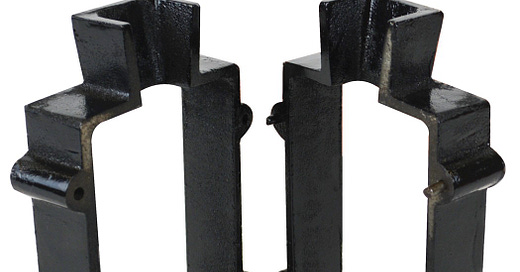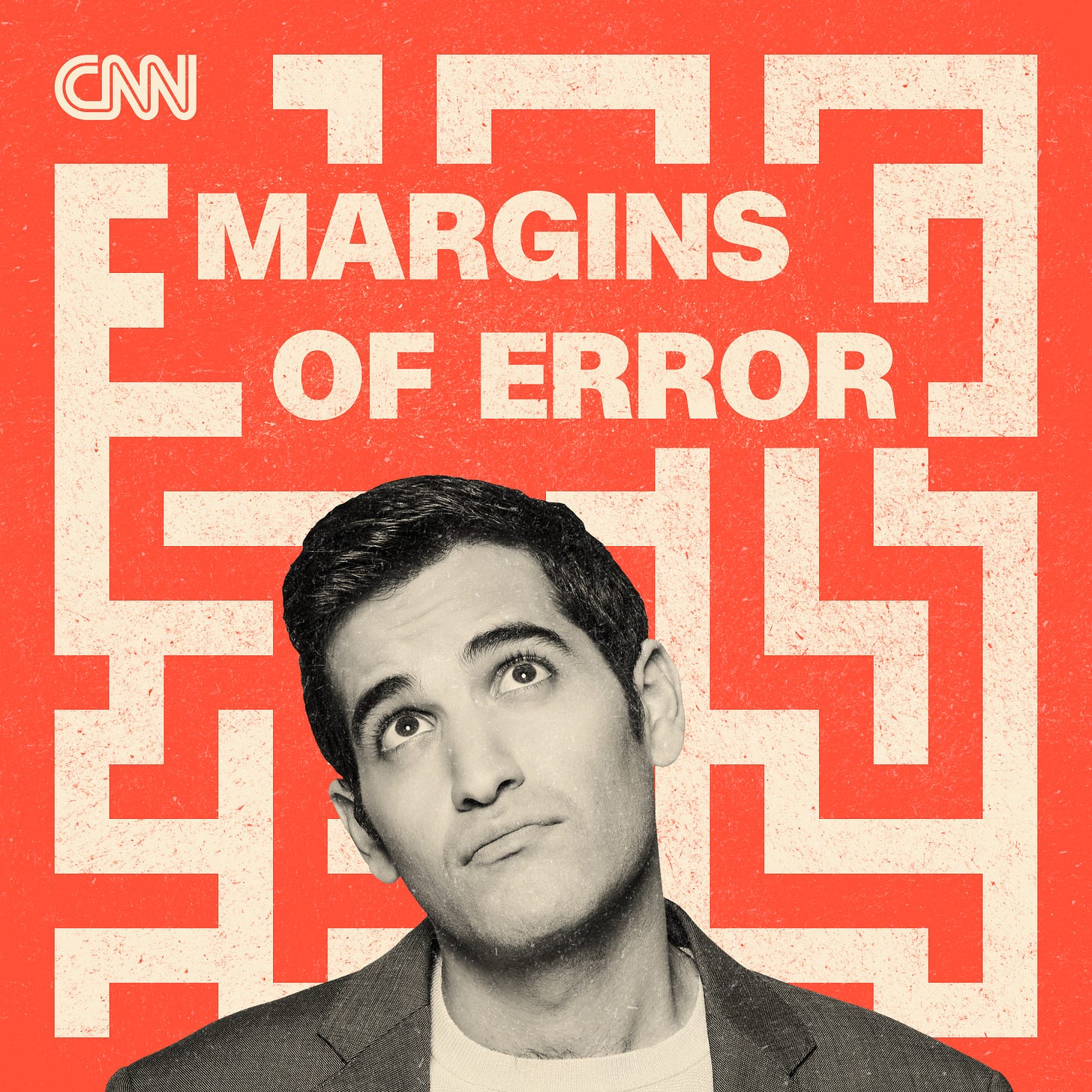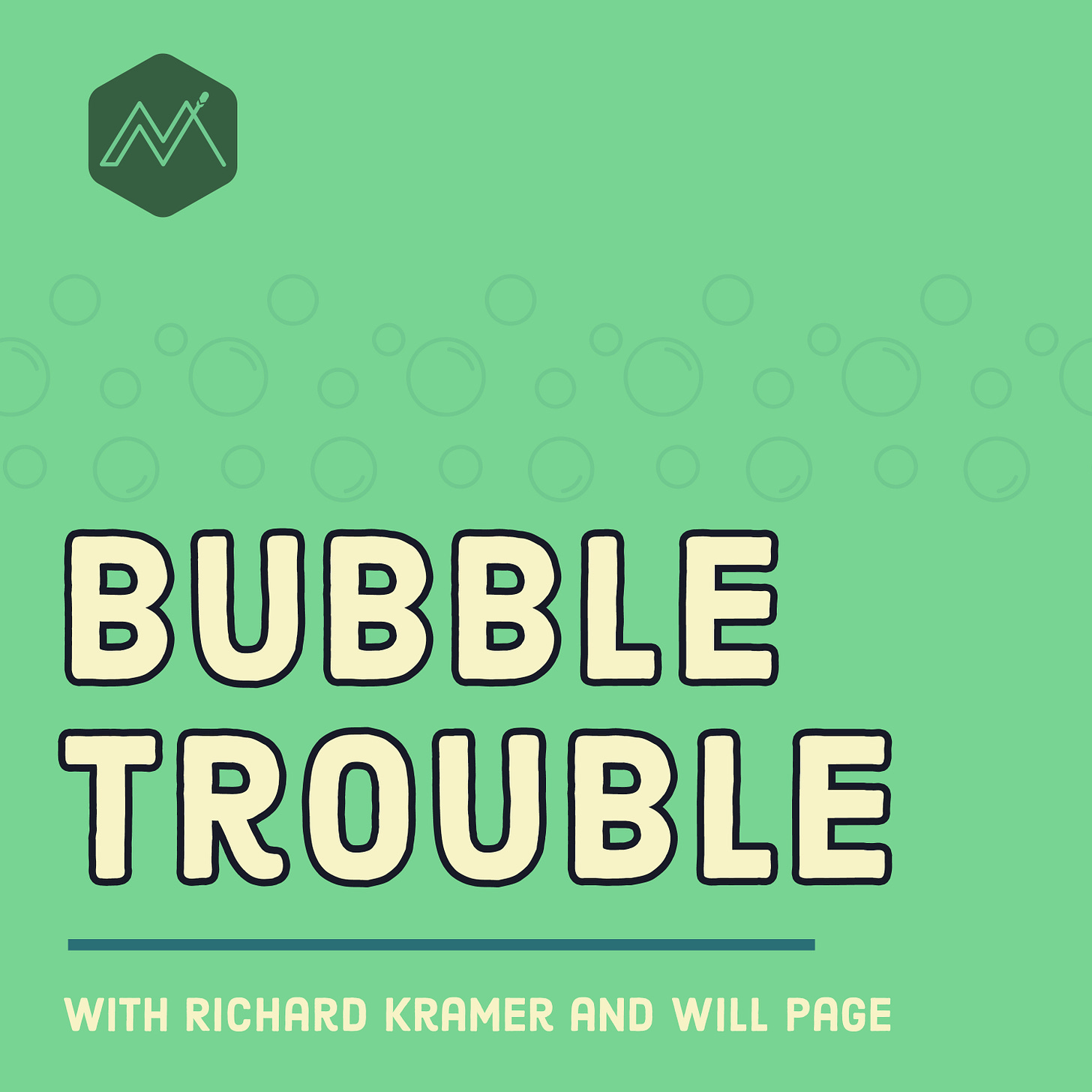Let’s Rethink Episodes
“How many episodes?” It’s often the first question that’s asked about a new podcast. It’s a sign of our obsession with form over function and often limits our thinking about what’s possible.
Welcome to Dispatch #16 of The Audio Insurgent.
Happy Monday after International Podcasting Day. I thought I’d wait a few days to send this out, assuming most of you made a long weekend of this festive occasion. And if anyone can tell me what International Podcasting Day is supposed to be, please do let me know. Usually I learn about International Podcast Day on International Podcast Day itself. Perhaps I should set up a calendar notification so I can properly decorate for next year?
Today I have one big thing, but will start with a small thing.
So let’s jump in...
[SMALL THING BEFORE THE BIG THING: OUR NEW SHOW MARGINS OF ERROR]
I’ve spent most of the summer working on a new series for CNN called Margins of Error and it’s super fun. It’s hosted by uber-data guy Harry Enten and each episode looks at an obscure piece of data that is surprisingly revealing, like why cremation has recently taken over burial as the most common way to dispose of a body, the number of couples who sleep separately (much larger than you think), why belief in ghosts has shot up more than 400% in the last 50 years, and the “rules” that guide our attitudes towards couples of different ages.
Last week’s episode is about Daylight Saving Time (and yes, it is “Saving Time,” not “Savings Time”). Data show that most people hate changing the clocks twice a year, but what stops us from doing anything about it is that no one can agree on what the solution should be. Regardless of your position, you’ll walk away surprised...and probably quite confused.
Harry is great to work with and the episodes are totally delightful. We made the season with a tight team of myself, two fantastic Magnificent Noise producers, Eva Wolchover and Sabrina Farhi, along with one of our sound designers, Kristin Mueller.
And while I’m showing and telling, our podcast Bubble Trouble has an amazing interview this week with Podnews editor James Cridland as part of a series of episodes on hyper-competition--exploring the idea that when quantity of choice goes up, quality goes down. I learned things from this episode, and so will you.
Margins of Error will be eight episodes to the show’s first season, and Bubble Trouble is basically a weekly show, approximately 22-minutes each...which brings us to our next topic…
[BIG THING: RETHINKING EPISODES] This discussion is (and should be) downright existential.
Episodes. At last check a few days ago, there were 115,844,603 (that number went up more than 400k since I first drafted this last week) of them floating around the podcast ecosystem. They are the basic building block the podcast industry is built on.
But what is an episode? And why do we often just repeat the same form over and over again?
Answer this: Is every episode in your podcast approximately the same format, production style, and approximate length?
Most of you will answer that, yes, they are.
I’m coming to the conclusion that how we define episodes--and the rigor we use in sticking to those definitions to organize our thinking about shows, is very limiting. (And limiting in a way that audiences don’t want us to limit ourselves.)
Lately, I’ve been counseling my colleagues and clients to rethink the definition of their podcast format. Instead, think about the experience you want to have with an audience, over what span of time, and then think about what combination of different types of production forms can best meet that objective.
This may sound odd coming from someone who spends a lot of time preaching the power of focus and consistency, but what I’m really advocating for here is having consistency in vision, but allowing that consistency to be expressed in different formats throughout your season. Consistency in delivery is proven to help grow podcasts. But what we deliver? That’s a much more open book.
Yet we don’t think that way. When we come up with an idea for a series, we come up with a format, and are pretty rigid about it. We then plug everything into that format without even thinking about it, forcing everything in the series into the same mold.
Why?
Let me back up.
Generally, we are obsessed with packing things into pre-defined boxes that we understand.
Many musicians get very frustrated when asked the genre of their music. Most are quick to say that, sure, they play X type of music (country, hip hop, blues, whatever), but the musician immediately caveats that their music is more than that binary definition. Johnny Cash famously said when asked “What kind of music do you play?” by answering “Johnny Cash music.” Yet people still ask that question, every day, to almost every musician they encounter.
In podcasting, we are equally obsessed with format and form.
Q: What’s your podcast?
A: It’s a eight episode true crime story.
A: It’s a weekly conversation about intersectionality.
A: It’s a ten-part series looking at the history of films about prisons.
And so on.
But what if the world you want to create in your podcast, the emotions you want to evoke, or the information you have to share don’t fit easily into the mold you’ve cast for your series?
What if you want to follow up on part of a story? What if there is a tangent you want to pursue? What if you just want to keep the story going beyond the 8 or 10 or 20 episodes you originally conceived?
I originally came to this thinking with a new show we’re working on that has 9 core episodes, but we found ourselves being pulled in two directions simultaneously. First, we were cutting material that didn’t fit, but was really interesting. Second, our distributor was telling us that we needed at least 14 episodes to sell it at the level we wanted.
So why were we throwing out interesting material...and the same time we were trying to figure out how to produce more episodes?
The truth was, there wasn’t a good reason for any of this.
Then we realized we were trying to fit the series into our original form, structure, and number of episodes, instead of thinking about what the best listening experience could be for the audience.
By the time we finished this thought exercise, we still had 9 “full” episodes, plus we outlined a number of “mini” episodes where we could explore other ideas. Now the season of 14 episodes will contain a mixture of lengths, production styles, and formats. We’re also talking about creating some virtual live events (via Facebook Live, Instagram Live, Clubhouse, Greenroom, whatever, etc) to bring the audience into the conversation after episodes air, too.
Since then, we’ve applied this thinking to two other projects--and it is kind of exciting. As I often tell people: In podcasting, there are no rules. So stop acting like there are rules.
This isn’t a particularly original idea. Radiolab figured this out well over a decade ago.
When Radiolab first started, it was a radio show (and soon after a podcast, but the radio was it’s almost primary distribution channel). The problem was, Jad and Ellen could only crank out ten episodes a year--two batches of five, released twice a year. Almost from the beginning, there was a constant pressure to produce more.
WNYC counseled public radio stations to treat Radiolab releases like “Shark Week” and plan a promotional push for the show to make that week special. However, it was still hard because that meant you had this wonderful show one week, the nothing more for 25 more weeks. That’s rough.
Several years later, as the show really segued into being podcast-first, the long gaps proved really difficult to manage. That was when Radiolab started to experiment with shorter episodes. They put out a new “full” episode every 4-6 weeks, and dropped a few segments or shorter conversations in between.
I have to admit I was one of the people who was a bit skeptical of this approach at first, but I quickly came around when I saw how the audience wasn’t bothered by it--in fact, they were delighted by the extra mini episodes.
Though they weren’t hour-long Radiolab episodes, it was still a Radiolab experience. It still contained the same sense of exploration and wonder, the same “wow” factor, and the same sense of discovery--it was just a different length and form.
There is some conventional thinking in podcasting that once a podcast establishes itself, that’s the time to start thinking of “extensions.” I feel this is incorrect. To a listener, there are no such things as extensions, they are all parts of the same thing. All these extensions are part of the whole, in your listeners’ eyes. That’s one of the shortcomings of both Apple and Spotify’s subscription offerings. While you can certainly upload and include different formats and lengths of episodes, both subscription schemes assume that those audio files are all a show can be--and they are reinforcing that pointless dogma with how they connect creators and audiences (or, more specifically, how they don’t connect them).
So, remember, there are no rules. Perhaps for your next project, you can free yourself from the rigidity of everything needing to be the same form and style. Because you know what? Most listeners won’t even notice or care. They come to your podcast for an experience--and the experience can be the same even though the vessel is different.
Formats can change over the course of a season, and a podcast can include things other than similarly-formatted audio files, even though the vision for the listener’s experience is rock solidly consistent. For another take on this, look at the series we did last year with TED called Far Flung (we’re working on a new season right now, hooray!). If you are familiar with the show, you’ll note that there are tons of different styles happening. Some are interviews, some are narrative-driven. Some are recorded on location, some have co-hosts, some focus on one guest--others on a group of guests. It’s all over the place. Some have rich sound design, some are quite spare. Yet, the show sounds incredibly consistent episode to episode because their intention is exactly the same.
Being disciplined and focused are not the opposites of being creative and open. As long as what you are doing is in service of finding new ways to surprise and delight listeners, they will love it--and you’ll have a great time playing with reinvention.
Okay, that’s it for this dispatch.
If this was forwarded to you or you read this online, would you mind subscribing?
And while this is free, you are also always welcome to buy my book or (even better) buy me a beer.
Make great things. I’ll be listening.
--Eric






